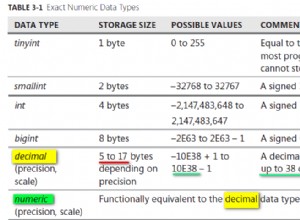Poniższe jest dość szybkie, zajmuje nieco ponad 6 minut z 10 milionami wierszy, ale przykładowa tabela ma mniej pól i indeksów niż tabela produkcyjna, więc spodziewaj się, że w twoim przypadku zajmie to trochę więcej czasu, jeśli zdecydujesz się z niej skorzystać!
Uwaga:przykład został wykonany w systemie operacyjnym Windows, więc będziesz musiał zmienić nazwy ścieżek i \r\n na \n, aby dostosować się do standardów linuksowych!
Oto moja istniejąca tabela (silnik InnoDB):
drop table if exists customers;
create table customers
(
customer_id int unsigned not null auto_increment primary key,
name varchar(255) not null,
country_id tinyint unsigned not null default 0,
key (country_id)
)
engine=innodb;
mysql> select count(*) from customers;
+----------+
| count(*) |
+----------+
| 10000000 |
+----------+
1 row in set (1.78 sec)
Utwórz nową wersję tabeli, która zawiera nowe wymagane pole:
drop table if exists customers_new;
create table customers_new
(
customer_id int unsigned not null auto_increment primary key,
name varchar(255) not null,
country_id tinyint unsigned not null default 0,
split tinyint not null default 0,
key (country_id)
)
engine=innodb;
Znajdź lokalizację swojego folderu Przesłane:
select @@secure_file_priv;
Eksportuj dane w kolejności PK ze starej tabeli klientów do formatu csv:
select * into outfile 'C:\\ProgramData\\MySQL\\MySQL Server 8.0\\Uploads\\customers.dat'
fields terminated by '|' optionally enclosed by '"'
lines terminated by '\r\n'
from customers order by customer_id;
Query OK, 10000000 rows affected (17.39 sec)
Załaduj plik customer.dat do nowej tabeli klientów:
truncate table customers_new;
set autocommit = 0;
load data infile 'C:\\ProgramData\\MySQL\\MySQL Server 8.0\\Uploads\\customers.dat'
into table customers_new
fields terminated by '|' optionally enclosed by '"'
lines terminated by '\r\n'
(
customer_id,
name,
country_id,
@dummy -- represents the new split field
)
set
name = nullif(name,'');
commit;
Query OK, 10000000 rows affected (6 min 0.14 sec)
Potwierdź, że nowa tabela wygląda dobrze:
select * from customers_new order by customer_id desc limit 1;
+-------------+-------------------+------------+-------+
| customer_id | name | country_id | split |
+-------------+-------------------+------------+-------+
| 10000000 | customer 10000000 | 218 | 0 |
+-------------+-------------------+------------+-------+
1 row in set (0.00 sec)
insert into customers_new (name, country_id, split) values ('f00',1,1);
Query OK, 1 row affected (0.07 sec)
select * from customers_new order by customer_id desc limit 1;
+-------------+------+------------+-------+
| customer_id | name | country_id | split |
+-------------+------+------------+-------+
| 10000001 | f00 | 1 | 1 |
+-------------+------+------------+-------+
1 row in set (0.00 sec)
Upuść starą tabelę i zmień nazwę nowej:
drop table customers;
Query OK, 0 rows affected (0.18 sec)
rename table customers_new to customers;
Query OK, 0 rows affected (0.05 sec)
select * from customers order by customer_id desc limit 1;
+-------------+------+------------+-------+
| customer_id | name | country_id | split |
+-------------+------+------------+-------+
| 10000001 | f00 | 1 | 1 |
+-------------+------+------------+-------+
1 row in set (0.00 sec)
To wszystko ludzie!




